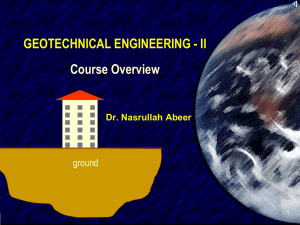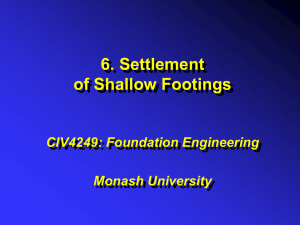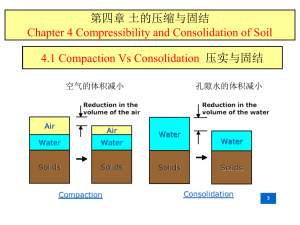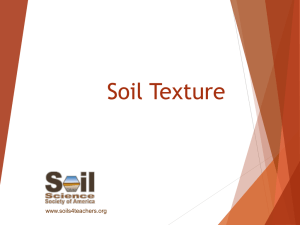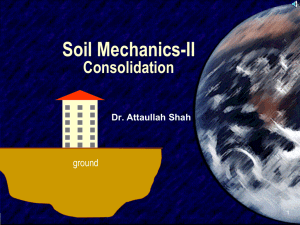Elastic Settlement
advertisement
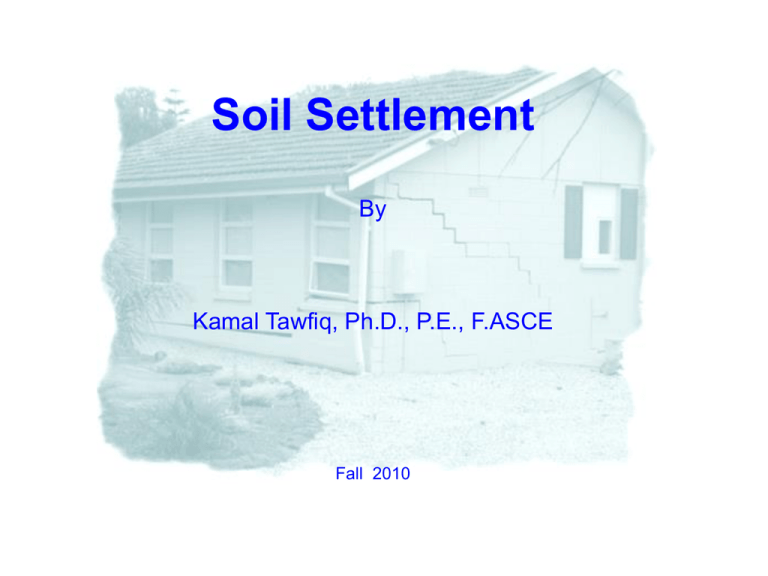
Soil Settlement
By
Kamal Tawfiq, Ph.D., P.E., F.ASCE
Fall 2010
Soil Settlement:
Total Soil Settlement = Elastic Settlement + Consolidation Settlement
Stotal = Se + Sc
Elastic Settlement or Immediate Settlement depends on
Elastic Settlement
{
{
Load Type (Rigid; Flexible)
Settlement Location (Center or Corner)
Theory of Elasticity
Time Depended Elastic Settlement (Schmertman & Hartman Method (1978)
Elastic settlement occurs in sandy, silty, and clayey soils.
By: Kamal Tawfiq, Ph.D., P.E.
By: Kamal Tawfiq, Ph.D., P.E.
Consolidation Settlement (Time Dependent Settlement)
* Consolidation settlement occurs in cohesive soils due to the expulsion of the water from the voids.
* Because of the soil permeability the rate of settlement may varied from soil to another.
* Also the variation in the rate of consolidation settlement depends on the boundary conditions.
SConsolidation = Sprimary + Ssecondary
Primary Consolidation
Secondary Consolidation
Volume change is due to reduction in pore water pressure
Volume change is due to the rearrangement of the soil particles
(No pore water pressure change, Δu = 0, occurs after the primary consolidation)
Water Table (W.T.)
Expulsion of
the water
Water
Voids
Solids
When the water in the voids
starts to flow out of the soil
matrix due to consolidation of
the clay layer. Consequently,
the excess pore water
pressure (Du) will reduce,
and the void ratio (e) of the
soil matrix will reduce too.
Elastic Settlement
Bqo
Se =
Es
Bqo
Se =
Where α =
Es
1
p
2
(1 - μs) α
(corner of the flexible foundation)
(1 - μs) α
(center of the flexible foundation)
2
2
[ ln ( √1 + m2 + m / √1 + m2 - m ) + m. ln ( √1 + m2 + 1 / √1 + m2 - 1 )
m = B/L
B = width of foundation
L = length of foundation
By: Kamal Tawfiq, Ph.D., P.E.
Se =
Bqo (1 - μs) α
Es
3.0
2.5
α
αav
αr
α, αav, αr
2.0
1.5
For circular foundation
α=1
αav = 0.85
αr = 0.88
1.0
3.0
1
2
3
4
5
6
7
8
9
10
L/B
Values of α, αav, and αr
By: Kamal Tawfiq, Ph.D., P.E.
Elastic Settlement of Foundation on Saturated Clay
Janbu, Bjerrum, and Kjaernsli (1956) proposed an equation for evaluation of the
average elastic settlement of flexible foundations on saturated clay soils (Poisson’s
ratio, μs = 0.5). Referring to Figure 1 for notations, this equation can be written as
Se = A1 A2 qoB/Es
where A1 is a function H/B and L/B, and is a function of Df/B.
Christian and Carrier (1978) have modified the values of A1 and A2 to some extent, and these are presented
in Figure 2.
2.0
L/B = ∞
L/B = 10
1.0
1.5
A2 0.9
5
A1 1.0
2
Square
Circle
0.5
0.8
0
5
10
Df/B
15
20
0
0.1
1
10
100
1000
H /B
Values of A1 and A2 for elastic settlement calculation (after Christian and Carrier, 1978)
By: Kamal Tawfiq, Ph.D., P.E.
Elastic Settlement Using the Strain Influence Factor: [Schmertman & Hartman Method (1978)]
Se = C1 C2 ( q - q) ∑ (Iz / Es ) Δz
The variation of the strain influence factor with depth
below the foundation is shown in Figure 1.
Note that, for square or circular foundations,
where
Is = strain influence factor
C1 = a correction factor for the depth of foundation embedment
= 1 - 0.5 [q / (q - q)]
Iz = 0.1 at z = 0
Iz = 0.5 at z = 0.5B
Iz = 0 at z = 2B
C2 = a correction factor to account for creep in soil
= 1 + 0.2 log (time in years /0.1)
q = stress at the level of the foundation
q = overburden pressure = γ Df
Similarly, for foundations with L/B ≥ 10
Iz = 0.2 at z = 0
Iz = 0.5 at z = B
Iz = 0 at z = 4B
Example:
BxL
q
Df
Iz
q = γ Df
Es
ΔZ1
ΔZ2
Is3
ΔZ3
s3
Average Is
ΔZ4
Depth, z
Average Es
Elastic Parameters of Various Soils
Young’s Modulus, Es
Type of Soil
Loose sand
Medium dense sand
Dense sand
Silty sand
Sand and Gravel
Soft clay
Medium clay
Stiff clay
MN/m2
10.35 - 24.15
17.25 - 27.60
34.50 - 55.20
10.35 - 17.25
69.00 - 172.50
2.07 - 5.18
5.18 - 10.35
10.35 - 24.15
Lb/in2
1,500 - 3,500
2,500 - 4,000
5,000 - 8,000
1,500 - 2,500
10,000-25,000
300 - 750
750 - 1,500
1,500 - 3,500
Es (kN/m2) = 766N
Es = 2q c
where
N = standard penetration number
qc = static cone penetration resistance
Note: Any consistent set of units can be used
The Young’s modulus of normally consoliadated clays can be estimated as
Es = 250c to 500c
For overconsolidated clays
Es = 750c to 1000c
where c = undrained cohesion of clayey soil
Poisson’s Ratio,s
0.20 - 0.40
0.25 - 0.40
0.30 - 0.45
0.20 - 0.40
0.15 -0.35
0.20 - 0.50
Depth (m)
0-1
1.0 - 1.5
1.5 - 4
4.0 - 6
Z (m)
Es (kN/m2)
Average Iz
1
0.5
2.5
2
8,000
10,000
10,000
16,000
0.233
0.433
0.361
0.111
(Iz /Es ).z (m 3/kN)
0.291 x 10-4
0.217 x 10-4
0.903 x 10-4
0.139 x 10-4
= 1.550 x 10-4
C1 = 1 - 0.5 (q / q - q )
= 1 - 0.5 [ 17.68 x 1.5 / 160 - (17.8 x 1.5)]
C2 = 1 + 0.2 log (5/0.1) = 1.34
Time = 5 years
Hence
2B
Sc = C1 . C2 (q -q)
(Iz /E s ) z
Example:
0
B x L = 3 m x 3m
= (0.9)(1.34)[160-(17.8x1.5)](1.55x10-4 )
= 249.2x10 m
24.9 mm
-4
= 17.8 kN/m3
Es (kN/m 2 )
q = 160 kN/m 2
1.5 m
0
4,000
0.4
0.6
12,000 20,000
2
2
4
4
6
6
8
Depth, z (m)
0.1 0.2
Averaged
Actual
1.5
Iz = 0.5
Iz
Consolidation Settlement
Consolidation Settlement (Primary Consolidation) = Sc = (Cc/1+e o) Hc . log [(Po + P)/Po]
Qdesign = Column Load
Normally
Consolidated
Clay
Stressed Zone
Sand
B
Caly
Hc
Hc/2
Overburden
Pressure
Po
2
1
2
1
Stress
Distribution
Sand
By: Kamal Tawfiq, Ph.D., P.E.
Consolidation Settlement
Loading
Normally
Consolidated Soil
Unloading
p
Sand
Sand
H clay/2
Hsand
2
1
Dp
p
Hclay
Void Ratio
H clay/2
Sand
Sand
Void Ratio
Void Ratio
Hsand
2
1
Clay
Sand
Sand
Dpp
Hclay
Dp
P
Dp
P
eo
Cc
Po
Log P
Po
Po + Dp
P
Log P
Po
Dp
Po +
P Log P
Cc H log(po +p)
Sultimate = H =
Po
CS H 1 + eo Po + DP
DH =
log (
)
P0
1 + eO
Po =
sand . Hsand + (
clay -
water ) . Hclay/2
By: Kamal Tawfiq, Ph.D., P.E.
Re loading
with Heavy Load
p2
Hsand
2
1
H clay/2
p
Dp
2
The soil become
overconsolidated
soil
Dp
P
p2
Dp
2
H clay/2
Hclay
V oid Ratio
Hsand
2
1
Hclay
Dp
P22
V oid Ratio
Dp
eo
Cs
Cs
Po
Po + Dp
P
=
Pc
DH =
Po
Log P
Pc
Po + Dp
P2
Log P
Po + P2
CS H
P Cs CHC H
log log (PPco + DP+) Cc H log
( H C= ) +
Sultimatelog
=
Po 1 +1e+ eO
1 + eO
1 + eo
Pc
Po PC
o
(
)
(
)
By: Kamal Tawfiq, Ph.D., P.E.
Re loading
with light Load
p2
Hsand
2
1
H clay/2
Dpp
The soil become
overconsolidated
soil
Void Ratio
Dp
P
p2
Dp
2
H clay/2
Hclay
2
Hsand
2
1
Hclay
Po + Dp
P2 2
Void Ratio
Dp
P22
eo
Cs
Po
Pc
DH =
Po
Log P
CS H
1 + eO
Pc
Cs H log
S
=
H
=
ultimate
P + DP2
1 + eo
log ( o
)
Po
Log P
(
Pc
Po
)
By: Kamal Tawfiq, Ph.D., P.E.
Determining The Preconsolidation Pressure (Pc)
Cassagrande Graphical Method
Void Ratio
5
6
3
1
4
2
7
Po
OCR = Pc/Po
OCR = 1
OCR > 1
OCR > 4
Pc
Log P
Normally Consolidated
Over Consolidated
Heavily Over Consolidated
By: Kamal Tawfiq, Ph.D., P.E.
Rate of Consolidation
Settlement at any time = Stime
Stime = Sultimate * U%
Sultimate= (Cc/1+eo) Hc . log [(P o + P)/P o]
U% = f (Tv) ....
Tv = f (cv) ......
Tv =
cv . t
(Hdr)2
Qdesign = Column Load
u =Excess Pore Water Pressure
Sand
Caly
Overburden
Pressure
Po
Hdr = Hc /2
P
P
Stress Distribution
2: 1 method
Uo
Hc = Layer Thickness
Sand
u =Excess Pore Water Pressure
By: Kamal Tawfiq, Ph.D., P.E.
